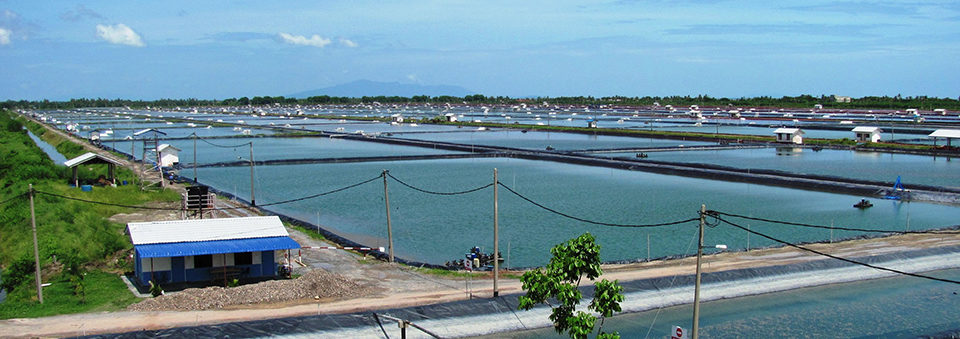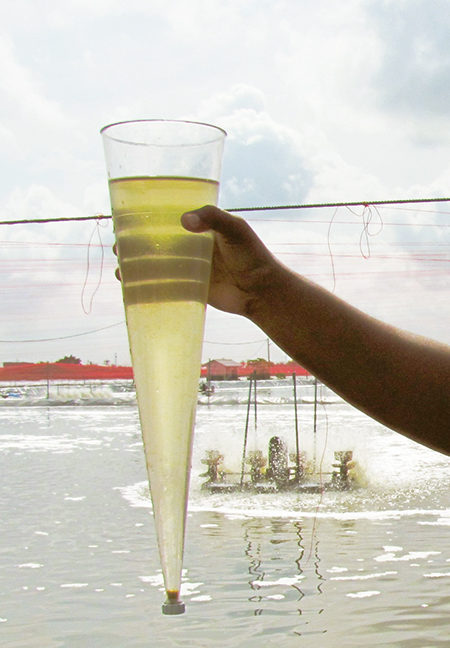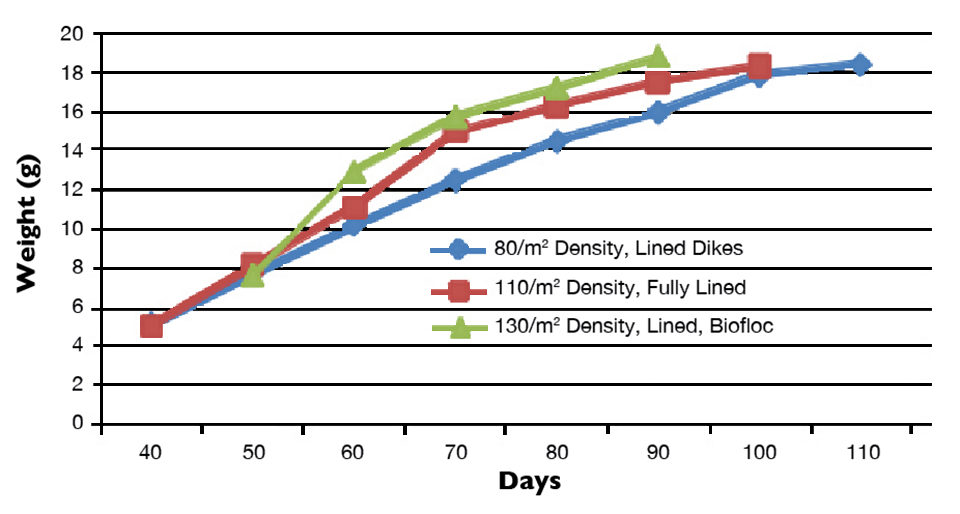Farm now integrated with a hatchery, processing plant

Pacific white shrimp farming has become increasingly competitive. Technology such as biosecure farm design and operation are becoming essential for sustainable production. Biofloc systems are seeing more use in both lined and earthen ponds as a method to stabilize the culture environment.
The value of these technologies has been proven by the re-engineering of a large shrimp farm in Malaysia. The main objective of the effort was to set a benchmark for future shrimp culture projects in Malaysia.
Blue Archipelago’s Arca Biru Sdn. Bhd. shrimp farm is located in Kedah, northwest of Kuala Lumpur. Initially known as Samak Aquaculture, the farm was established in the early 1990s for the culture of black tiger shrimp. Blue Archipelago took over the farm in early 2008. The farm is now integrated with a hatchery and processing plant in the vicinity.
Original farm design
The original farm layout was a pond culture system with excellent seawater intake from an extended 2.4-km canal. The farm had 226 earthen ponds, most of which were 0.8 hectares (ha) in size, arranged in rows with supply and discharge drainage canals on opposite sides.
Two large reservoirs supplied treated seawater, while sedimentation ponds treated waste water before discharging back to the sea. The main supply gates were based on irrigation canal gates with wooden planks to let water into secondary supply canals. The outlet or harvest gates of culture ponds used conventional wooden sluice planks for flow-through pond operation. There was no central drain or harvest pit in the system.
Farm redesign
In early 2010, the farm was redesigned from rows of single ponds to a bio-secure modular system lined with high-density polyethylene (HDPE) with reservoirs for water treatment. Two modules were fully lined with HDPE, and the remaining modules were lined on pond dikes only.
The farm still has 226 ponds, but each new module consists of 20, 0.8-ha ponds and two culture ponds of 0.4 to 0.6 ha. Four 0.8-ha ponds beside the main supply canal were modified into reservoirs for each module. All inlet supply and discharge gates were reconstructed to bio-secure design to make sure there are no leakages.
A central drain system was installed to get rid of sludge during culture operation and increase the carrying capacity of the ponds. The revised seawater supply system passes water through the four treatment ponds before it reaches the culture ponds. This ensures that only treated water enters culture ponds within a module.
Biosecure operation
The farm is operated with minimum water exchange, semi-biofloc and biofloc technology. Biosecurity measures include 250-µ screens to prevent crustacean carriers from entering the modules, eradicating crab larvae with chlorine or approved crustacide, crab fencing, bird scare lines and water aging. Strict biosecurity protocols are also applied on movements of farm personnel, equipment and guests entering farm facilities.
The numbers and positions of paddlewheel aerators are standardized in line with stocking density and culture system. The strategy is to have dissolved oxygen at acceptable levels by operating aeration 24 hours daily with adjustments according to culture days and by day and night.
Initial cycle

The first production cycle was started the last week of May and concluded on the third week of December 2010. Only seven of nine modules were operated due to delays in construction. Specific pathogen-free white shrimp (Litopenaeus vannamei) were the only species stocked.
For fully lined ponds, a semi-biofloc system was used, with lower stocking density of 110 postlarvae per square meter and a feeding program that included grain pellets. Two 0.4-ha ponds were tried using a full biofloc protocol and stocking density of 130 shrimp per square meter. The remaining lined ponds with earthen bottoms also used a biofloc system, but only as a means to control water quality.
Temperature, salinity, dissolved oxygen, pH, alkalinity and other pond water quality parameters were monitored and found within acceptable ranges during the culture operation. In addition, biofloc volume was controlled below 5 mL/L for semi-biofloc and below 10 mL/L for biofloc systems.
Performance
As at other farms in the vicinity, Arca Biru was faced with serious outbreaks from white spot syndrome virus (WSSV) before the redesign. During its first new cycle, viral incidents were common in the vicinity. On one occasion, dead WSSV-positive shrimp were found within the main supply canal.
The production cycle was a success, however, without viral outbreaks. The farm averaged over 12.0 metric tons (MT) shrimp/ha for ponds lined on dikes only, whereas for fully-lined ponds, the average was over 16.2 MT/ha (Table 1). Two ponds with biofloc systems averaged over 22.5 MT/ha with average shrimp sizes of approximately 18 grams.
Taw, Production performance, Table 1
| Production Parameter | 0.4-ha Pond Lined, Biofloc | 0.8-ha PondLined, Semi-Biofloc | 0.8-ha Pond Lined Dikes |
|---|
Production Parameter | 0.4-ha Pond Lined, Biofloc | 0.8-ha PondLined, Semi-Biofloc | 0.8-ha Pond Lined Dikes |
|---|---|---|---|
| Number of ponds | 2 | 19 | 119 |
| Aerator energy (hp) | 14 | 24 | 20 |
| Stocking density | 130 | 110 | 83 |
| Days | 90 | 101 | 111 |
| Survival | 89.16 | 81.35 | 83.19 |
| Mean body weight (g) | 18.78 | 18.31 | 17.80 |
| Feed-conversion ratio | 1.39 | 1.58 | 1.77 |
| Average daily growth (g) | 0.21 | 0.18 | 0.16 |
| Average harvest (kg) | 9,006 | 12,950 | 9,616 |
| Production (kg/ha) | 22,514 | 16,188 | 12,019 |
| Production/power input (kg/hp) | 643 | 540 | 481 |
However, the outstanding achievement in the cycle was in a biofloc system with stocking density of 130 postlarvae per square meter, where shrimp reached over 18.8 grams in just over 90 days of culture while still retaining the production of over 22.5 MT/ha (Fig. 1). Compared to growth rates recorded two to three years ago at the farm, the growth has increased significantly.

From an economic perspective, the most significant factor achieved with the farm redesign was a reduction in culture period. The 110- to 120-day cycles that were the previous norm were reduced to 90 to 100 days, which could potentially increase production from 2 cycles to 2.5 cycles/year.
(Editor’s Note: This article was originally published in the March/April 2011 print edition of the Global Aquaculture Advocate.)
Authors
-
Nyan Taw, Ph.D.
Blue Archipelago Bhd.
T3-9 KPMG Tower
8 First Avenue, Persiaran
Bandar Utama, 47800 Petaling Jaya
Selangor, Malaysia -
Poh Yong Thong
Blue Archipelago Bhd.
T3-9 KPMG Tower
8 First Avenue, Persiaran
Bandar Utama, 47800 Petaling Jaya
Selangor, Malaysia -
Ling Teck Ming
Blue Archipelago Bhd.
T3-9 KPMG Tower
8 First Avenue, Persiaran
Bandar Utama, 47800 Petaling Jaya
Selangor, Malaysia -
Chatree Thanabatra
Blue Archipelago Bhd.
T3-9 KPMG Tower
8 First Avenue, Persiaran
Bandar Utama, 47800 Petaling Jaya
Selangor, Malaysia -
Kamel Zikry Salleh
Blue Archipelago Bhd.
T3-9 KPMG Tower
8 First Avenue, Persiaran
Bandar Utama, 47800 Petaling Jaya
Selangor, Malaysia
Tagged With
Related Posts

Responsibility
A look at various intensive shrimp farming systems in Asia
The impact of diseases led some Asian shrimp farming countries to develop biofloc and recirculation aquaculture system (RAS) production technologies. Treating incoming water for culture operations and wastewater treatment are biosecurity measures for disease prevention and control.

Health & Welfare
A comprehensive look at the Proficiency Test for farmed shrimp
The University of Arizona Aquaculture Pathology Laboratory has carried out the Proficiency Test (PT) since 2005, with 300-plus diagnostic laboratories participating while improving their capabilities in the diagnosis of several shrimp pathogens.

Health & Welfare
Biofloc technology holds potential for carnivorous fish species
Juvenile carnivorous African catfish performed well in biofloc-based systems, which could help produce better quality and more disease-resistant seed of this important aquaculture species and support the expansion of African catfish farming industry.

Responsibility
Biofloc technology options for aquaculture
Biofloc technology offers advantages for the sustainable culture of shrimp and some species of fish.


